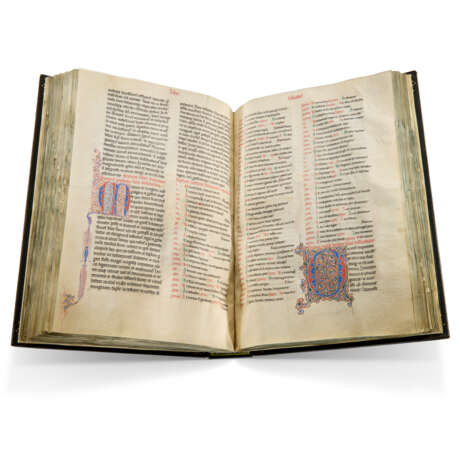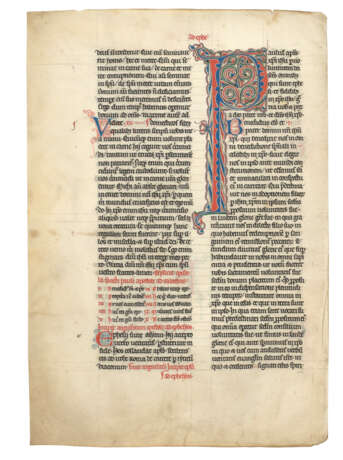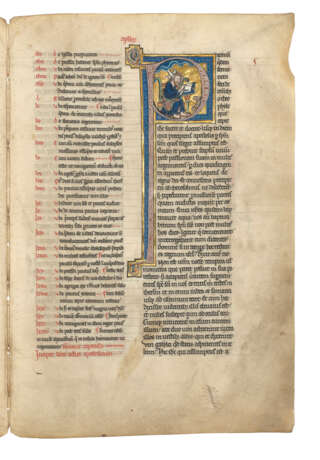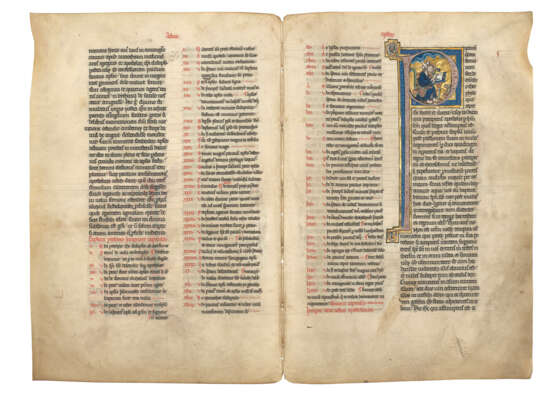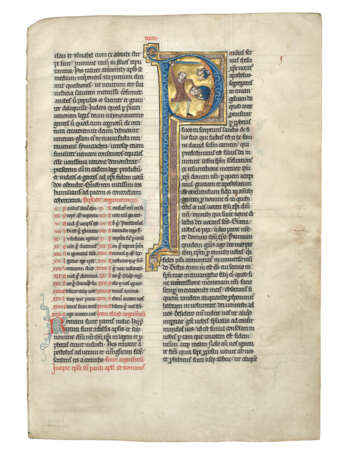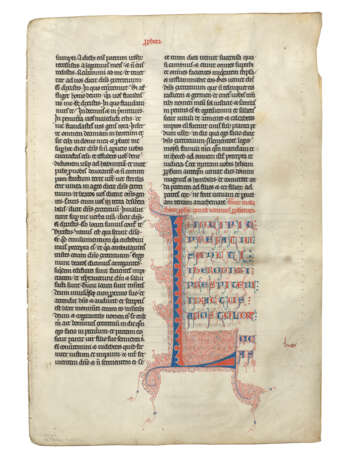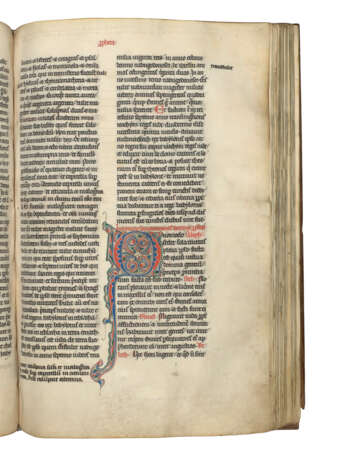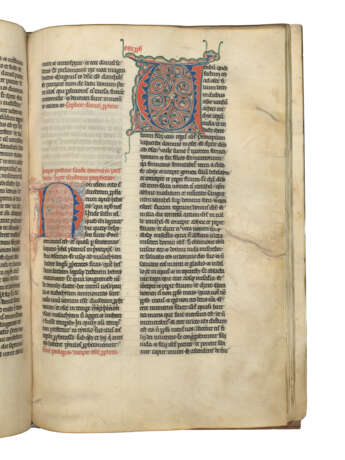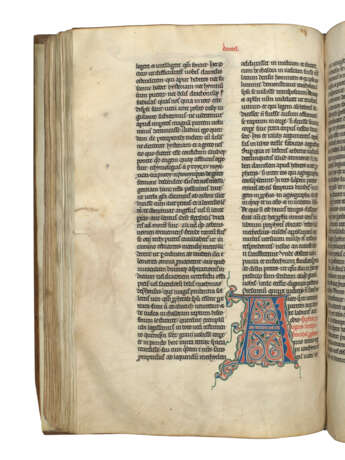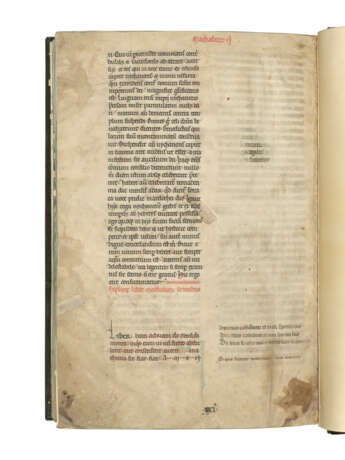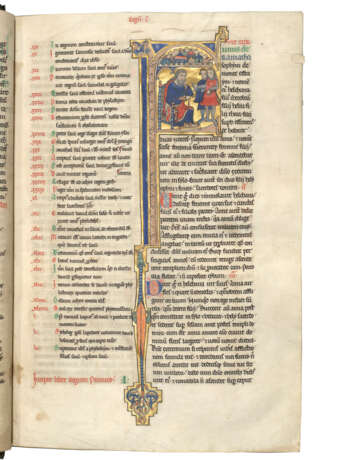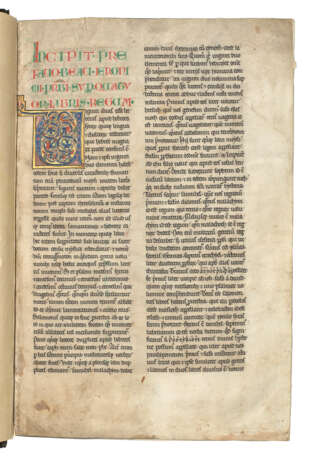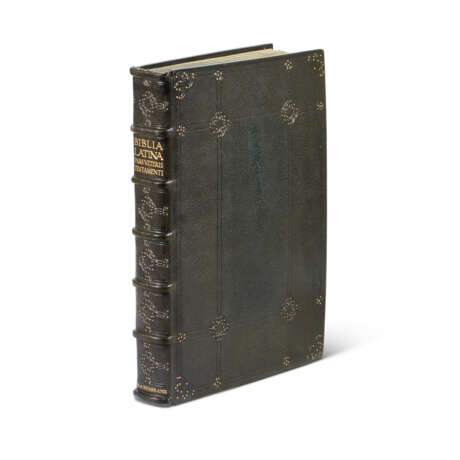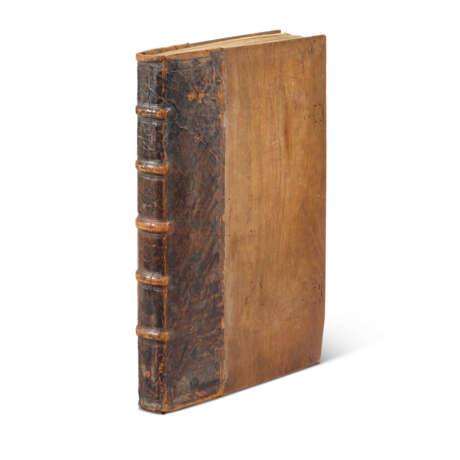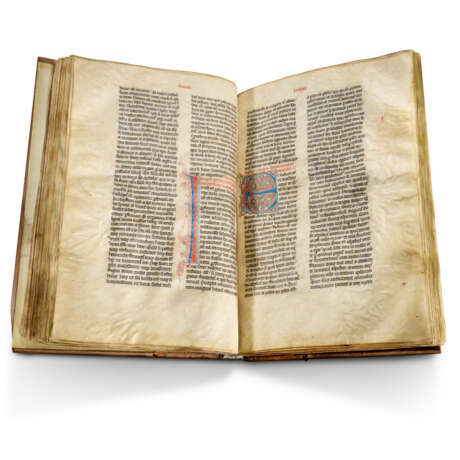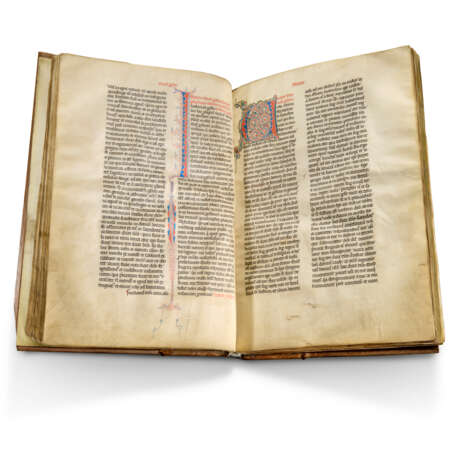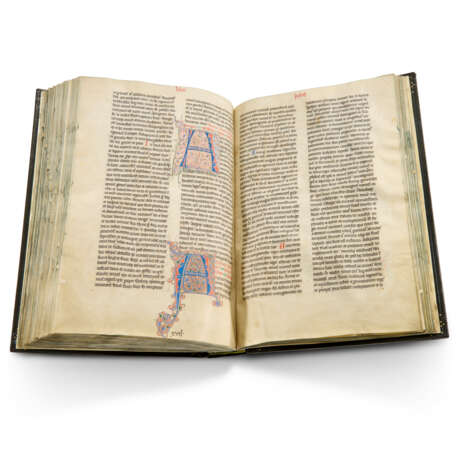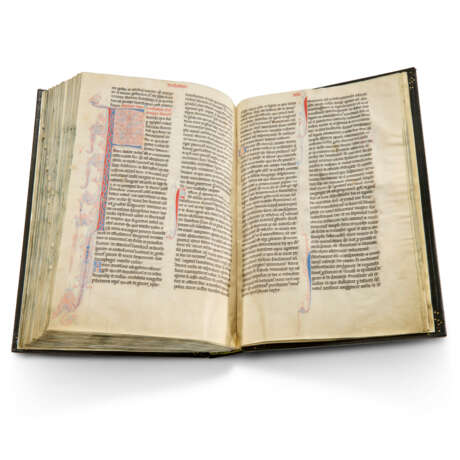ID 1214889
Los 9 | The Geraardsbergen Bible
Schätzwert
£ 700 000 – 1 000 000
The Geraardsbergen Bible, vols II and III, in Latin, illuminated manuscript on vellum [Southern Netherlands, late 12th century]
The impressive giant Bible from the Abbey of St Adrian at Geraardsbergen: a very rare example in private hands of a 12th-century display Bible, the epitome of Romanesque book production.
Vol. II: 430 x 290mm. 201 leaves: ii + 19(of 10, i assumed pastedown), 2-910, 108, 115(of 6 - ii, text continuous ff.98v-99), 12-1710, 1812, 19-2010, 217(of 8, viii assumed pastedown) + ii, catchwords and signatures I-XX, modern pencilled foliation bottom left, text complete, 41 lines in two columns written above top line, ruled space: 326 x 215mm, headings, chapter numbers and running-titles in red, opening heading in one-line capitals alternately in red and green, headings in red, some decorated in green, first line of some books in green, chapter lists with one-line initials alternately in red and green, one-line initials in red or blue with a few in green, two-line flourished initials extending into margins alternately in red with blue and light blue with red, one large and one very large flourished initial in blue and red with marginal extensions, eight very large red and blue puzzle initials flourished in red, blue and green forming elaborate marginal extensions, eighteen very large initials painted with foliate scrolls in red, blue and green, one large illuminated initial on a gold ground, one large historiated initial with dragon extension on a gold ground (margins cropped, on some leaves slightly into the marginal extensions; the upper margin f.64 and the lower margins ff.84, 148, 165 and 196 made up with modern vellum, small hole in text perhaps from lost repair f.45 and in margin f.103, repairs to edges of gutter on some leaves, slight staining to opening leaf and leaves towards end). The Arts and Crafts binding is in dark green morocco gilt by Douglas Cockerell at W.H. Smith, the WHS stamp used for Cockerell’s own designs 1905-1914. Half morocco box.
Provenance:
(1) Abbey of St Adrian, Geraardsbergen (Grammont): ownership inscription with curse on anyone who steals the book 'Liber beati adriani de Geraldimonte. Siquis eum vi vel furto abstulerit aut consenserit averti anathema sic fiat fiat amen', with a further curse 'Si quis furetur mala morte tunc morietur', f.201v. The Benedictine Abbey, originally of St Peter, was founded at Dikkelvenne in the 8th century and moved c.1100 to Geraardsbergen; the Abbey became a major centre of pilgrimage to the relics of St Adrian, hence the changed dedication in 1174. Little is known of its intellectual life but a Benedictine Abbey of its wealth and standing was bound to have a scriptorium and significant library. The Bible was most probably copied by the monks, perhaps with professional help, but it could have been sourced elsewhere. The Abbey was suppressed in 1796: books and liturgical objects had already been removed with the arrival of the French Revolutionary armies in 1792 and were dispersed piecemeal. Some manuscripts are known with certain provenances from the Abbey: four that apparently left with vol. II of the Bible are listed below.
(2) Charles Welvaert (1797-1866), priest at Gentbrugge from 1832: Catalogue de la Bibliothèque de feu Mr Charles Welvaert, Ghent, 11-12 December 1866, lot 10, Bibliae pars manuscripta à libr. Reg. ad II Mach. assez gros in-fol. sur parchemin, demi-rel. chagr. brun. – Provenant de l’Abbaye de St. Adrien à Grammont. Welvaert’s collection, chiefly of theological or liturgical books acquired at sales locally and abroad, was increased when he inherited from his brother, the Dean of Ieper (Ypres), Christophorus Bernardus Welvaert (1783-1864). Curate in Geraardsbergen from 1815 to 1819, he is a likely source of the Geraardsbergen volumes, lots 10-14 in the 1866 sale, which included the famous Geraardsbergen Breviary (Abbey of Maredsous, Lorent, 2021); for Christophorus, F. De Chou, ‘Biografisch repertorium van de parochiegeestelijken van Geraardsbergen 1802-2012’, Gerardimontium, 249, 2013, p.6.
(3) Franz Trau (1842-1905): his sale Vienna, Gilhofer and Rauschburg, 27-28 October 1905, lot 8, with the binding described as modern half leather with applied late gothic metal bosses and cornerpieces. Trau added to the library left him by his father, Carl Trau (1811-1887), who had a particular interest in medieval religious art; both were well travelled.
(4) Charles Harold St John Hornby (1867-1946): his book label inside upper cover; his MS 15, purchased from Quaritch in 1910. A partner in W.H. Smith where he promoted the bindery, Hornby was an informed and dedicated bibliophile, establishing the famed Ashendene Press, and collecting outstanding manuscript and printed books.
(5) Major John Roland Abbey (1894-1969): his bookplate inside upper cover; his ms J.A. 3175, purchased with 68 other manuscripts in September 1946 from Hornby’s executors, on the recommendation of Sir Sydney Cockerell, Douglas’s brother; these were the foundations of Abbey’s extraordinary library of manuscripts, exceptional for quality as well as size; his sale, Part IX, the Hornby Manuscripts, Part II, Sotheby’s, 25 March 1975, lot 2943, acquired by the British Rail Pension Fund.
(6) Sir Paul Getty KBE (1932-2003), founder of the Wormsley Library: purchased in 1988 as the British Rail Pension Fund realised its investment in works of art.
(7) The Schøyen Collection, MS 6; purchased from Heribert Tenschert, Leuchtendes Mittelalter II, Katalog XXV, 1990, no 5, thus reuniting it with vol. III (below) after a separation of nearly two centuries.
Vol. III: 452 x 303mm. 121 leaves + 15 loose leaves, detailed under Provenance: 17(of 10, lacking i-iii), 2-1210, 134(of 10, lacking v-x), modern pencilled foliation top right, + 15 loose leaves, including the bifolium v-vi of gathering 13, some consecutive, catchword f.7v, signatures I-XII and two loose leaves with XV and XVII, 40 lines ff.1-18 and 41 lines from f.18v, in two columns written above top line, ruled space: 316 x 210mm and 322 x 210mm, prickings in margins, headings, one-line initials of chapter lists, chapter numbers and running-titles in red, heading and opening to prologue to Acts in one-line capitals alternately in red and blue, one-line initials alternately in red and blue, two-line flourished initials extending into margins alternately in red with blue and light blue with red, seven large flourished puzzle initials in red and blue with elaborate marginal extensions, twenty-two large initials painted with foliate scrolls in red, blue and green, two large historiated initials on gold grounds with marginal extensions, one with foliate terminals and one with heads, human and dragon (lacking three leaves at beginning and leaves and gatherings at end, early small loss to text supplied in Gothic hand in margin f.26, outer margins excised ff.39 and 56, some original repairs in margins unstitched, repairs to some leaves in lower margins into gutter, one lost, some pages cockled, wear to margins). 15th-century blind stamped half leather over wooden boards, possible remboîtage (lacking central bosses and straps or clasps, restored for Eichenberger c.1985). Half morocco box.
Provenance:
(1) The Abbey of St Adrian at Geraardsbergen: although no ownership marks remain, the volume matches vol. II in script, design and some annotations and repairs; vol. II has been trimmed so that Vol. III, which retains its pricking, is larger. The opening leaves of vol. III were ruled for, and written with, 40 lines, apparently a mistake which was abruptly corrected to 41 lines on the verso of the first folio of the third gathering. The longer chapter divisions of the 13th-century Paris Bible have been added in Arabic numerals by the same post-medieval hand in vol. II and in vol. III from ff.8v-11 and 25 onwards, where ff.1-8 and 11v-24 were updated by an earlier hand in Roman numerals. The half binding recorded on vol. II in 1866 may indicate a binding history shared with vol. III. The differences do not outweigh the similarities. In vol. III the text of the Prophets, with no numbered chapter lists, is largely articulated by one-line initials instead of the two-line initials of vol. II. These do appear, the first on f.36v for Jeremiah 39, but only consistently in Acts and the Epistles, following chapter lists. In vol. III guide letters for the coloured initials survive from f.105 onwards and annotations and corrections were added in a formal gothic hand, working from partially erased cursive guide texts e.g. f.51v.
(2) Antiquariat Dr Walter Eichenberger, Beinwil am See, Switzerland: acquired from a Swiss private collection; a pencilled note inside the upper cover records 24/25 loose leaves, elsewhere described as from Acts and the Epistles and being placed at the end of the volume. The bound volume was sold at Sotheby’s 24 June 1986, lot 78; the loose leaves were retained by Eichenberger and dispersed; the subsequent provenances of the 21 known are given below.
(3) The Schøyen Collection MS 6; after acquisition of the bound volume, a further fifteen leaves were successfully added to the collection, see below.
Fifteen leaves (a) –(o), most with very small pencilled annotations of content and/or provenance;
(a) – (b) Malachi, opening in 3:6, continuing the text from f.121, to the end; preface to Acts (Stegmüller, Repertorium Biblicum, S.640); chapter list for Acts (De Bruyne, Sommaires, divisions et rubriques de la Bible latine, A); Acts from 1:1-2:14. This bifolium formed ff.122-123. Christie’s Online Auction, 3 December 2015, lot 6, with leaves (d), (h) and (i), sold for £80,500.
(c) Acts 20:9-21:26, purchased from Eichenberger in 1991.
(d) Canonical Epistles: James 3:12-end; chapter list for 1 Peter (S.325,15; De Bruyne A); 1 Peter 1:1-3. Christie's, 2015.
(e) 1 Peter 3:10-end, chapter list for 2 Peter (S. 325,16; De Bruyne A; final item numbered xx on (e) not xxi); 2 Peter 1:1-3. Sotheby’s, 19 June 2001, lot 6.
(f) 2 Peter 3:10-end; chapter list for 1 John (S. 325,17; De Bruyne A); 1 John 1:1-7; the final leaf of gathering 15 from the signature. Acquired from the sculptor Robert Müller (1920-2003) in 1991.
(g) Opening in the preface to the Pauline Epistles (S. 670); argument to Romans (S. 674), continuing on (h). Acquired from Göran Wikström, Saltsjöbaden, Sweden in May 1991.
(h) – (i) end of the argument to Romans (S. 674); chapter list for Romans (De Bruyne B3, final item numbered xxix on (i) not xxx); argument to Romans (S. 677); Romans 1:1-4:18; the bifolium continues the text from (g). Christie’s, 2015.
(j) Romans 14:17-16:26. Acquired from the sculptor Robert Müller (1920-2003) in 1991.
(k) 1 Corinthians, opening in 3:4-6:11; acquired from Quaritch in 1991.
(l) 2 Corinthians 4:6-7:9, continuing on leaf (m); the final leaf of gathering 17 from the signature. Acquired from Eichenberger in 1991.
(m) 2 Corinthians 7:9-10:8, continuing the text from leaf (l); the text continues on leaf (n). Acquired from Christopher de Hamel, his ms 121, in 1991.
(n) 2 Corinthians 10:8-12:17, continuing the text from (m); Quaritch, Catalogue 1056 (1985), no 18; acquired in April 1990.
(o) Galatians 4:27-end; chapter list for Ephesians (De Bruyne B2, with final item numbered x on (o) not viii); argument to Ephesians (S. 718 with Ephesiani instead of Ephesii); Ephesians 1:1-13. Acquired from the sculptor Robert Müller (1920-2003) in 1991.
Content:
Vol II: Old Testament: preface to 1-4 Kings (1-2 Samuel, 1-2 Kings; Stegmüller 323), chapter list for 1 Kings (1 Samuel; Biblia Sacra iuxta latinam vulgatam, 1926-1995, series B) ff.1v-2, 1 Kings ff.2-17v, chapter list for 2 Kings (2 Samuel; BSLV series B b) ff.17v-18, 2 Kings ff.18-30v, chapter list for 3 Kings (1 Kings; BSLV series B b) ff.30v, 3 Kings ff.31-46, chapter list for 4 Kings (2 Kings; BSLV series B b) f.46, 4 Kings ff.46-60v, preface to 1-2 Paralipomenon (1-2 Chronicles; S. 328) f.61, 1 Paralipomenon ff.61v-74, 2 Paralipomenon ff.74-91, preface to Esdras (Ezra, S. 930) f.91, Esdras ff.91v-96, Nehemiah (2 Esdras,) ff.96-103, preface to Proverbs (S. 457) f.103, chapter list for Proverbs (BSLV series A b) f.103, Proverbs ff.103-113, preface to Ecclesiastes 'Petrus[:] queso te quid est […] ex spirituali veritate definivit', from the Dialogues attributed to Gregory the Great (IV 3) f.113, chapter list for Ecclesiastes (BSLV series A b) ff.113v-114, Ecclesiastes ff.114-117v, Song of Songs, with verses attributed to different voices ff.117v-119, chapter list for Wisdom (BSLV series A a) f.119, Wisdom ff.119v-126v, preface to Ecclesiasticus (S. 26) f.126v, chapter list for Ecclesiasticus (BSLV series A a) ff.126v-127, Ecclesiasticus ff.127-146, preface to Job f.146 (S. 344), Job ff.146v-158, preface to Tobit (S. 332) f.158, Tobit ff.158-162v, preface to Judith (S. 335) f.162v, Judith ff.162v-168, preface to Esther (S. 341+343) ff.168-169, Esther ff.169-174v, 1 Maccabees ff.174v-190v, 2 Maccabees ff.190v-201v.
Vol. II contains the historical and poetical or sapiential books, omitting Psalms, as was often the case. Psalters were widely copied as independent volumes, suited to their central role in the liturgy, and were evidently not considered necessary in all lectern Bibles (for the evolution of the Bible, see C. de Hamel, The Book. A History of the Bible, 2001).
The complex textual history of the books 1-2 Esdras, Ezra-Nehemiah, may explain the irregular gathering 11 and its excised leaf before f.99, where the running title changes from liber hesdre to nehemye; Nehemiah is divided at 7:70, as marked by the heading and, exceptionally, a five-line elaborately flourished initial. The shorter gathering and excision may have resulted from a determination to clarify the text in a way that the scribe had not originally anticipated. Further study might determine whether the text followed one source or was individually edited, presumably at Geraardsbergen. In Ecclesiasticus, chapter numbers were omitted, except for xliiij – xlvii. A later hand added them in ink up to cxxiii, perhaps ending because there are only 127 numbered chapter summaries and 143 two-line initials dividing the text.
Vol. III Bound volume: Isaiah, lacking opening, beginning in 5:2 f.1, prologue to Jeremiah (S. 487) f.24v, Jeremiah f.25, Lamentations f.55, Baruch f.58, preface to Ezechiel (S. 492) f.61v, Ezechiel f.62, preface to Daniel (S.494) ff.89, Daniel f.89v, preface to the Minor Prophets (S. 500) f.101, Hosea f.101, Joel f.104v, Amos f.106, Obadiah f.109, Jonah f.109v, Micah f.110v, Nahum f.112v, Habbakuk f.113v, Zephaniah f.114v, Haggai f.115v, Zechariah f.116v, Malachi, lacking end, breaking in 3:6 f.121, the text continuing on leaves (a) – (b) from Malachi to Acts 2:14.
From that point Acts, the Canonical or Catholic Epistles and the Pauline Epistles survive in a fragmentary state, with nothing known after Ephesians 1:13. See above under Provenance for details of the text on leaves (a) - (o) that are included in the current lot. They can be supplemented by five further leaves and one partially recorded lost leaf. The text on these six leaves is (or was):
(1) Acts 10:44-12:21, Dublin, Chester Beatty Library, W 222.1; sold Sotheby’s 8 July 2014, lot 11 (b).
(2) The leaf opening the preface to the Canonical Epistles was accidentally destroyed in a dealer’s possession, as reported Sotheby’s 1 December 1998 lot 9, see (6) below.
(3) 2 Peter 1:3-3:10, sold Bruges, Van de Wiele Auctions, 25 March 2023, lot 751; the leaf came between (e) and (f).
(4) 1 Corinthians 6:11-8:11, London, Richard Linenthal Collection; sold Sotheby’s 7 July 2015 lot 4, from the De Kesel Collection; the leaf followed (k).
(5) 1 Corinthians 11:5-13:8, sold London, Forum Auctions, 30 September 2021, lot 219.
(6) 2 Corinthians 12:17-Galatians 1:1-2:10, sold Sotheby’s 1 December 1998 lot 9, the catalogue describing the text as starting in 2 Corinthians 12:16; the leaf followed (n).
On the assumption that the volume continued in gatherings of ten, the original placing of the leaves can partly be reconstructed from the signatures and the two bifolia with continuous text. Although uncertainty over any prologues means the missing text cannot be calculated exactly, it is clear that the Gospels cannot have followed Acts and were evidently omitted along with the Psalms, as in other Romanesque Bibles e.g. that of c.1100 from the Benedictine Abbey of St Amand in Hainault (Valenciennes, BM mss 9-11). Gospel Books and Lectionaries were also widespread as independent volumes, as was the Apocalypse. It, however, was frequently placed at the end of the New Testament and may have closed vol. III.
Vol. I, assumed lost without trace, must have contained the opening books from Genesis to Ruth, so that the Bible was divided with the Octateuch in vol. I, the historical and sapiential or teaching books in vol. II, and the Prophets, Acts and Epistles, and possibly the Apocalypse, in vol. III.
Owned chiefly by monasteries and great churches who wanted authoritative and impressive Bible texts, the giant Bibles of the 11th and 12th centuries - ‘one of the great phenomena of twelfth-century culture’ (de Hamel, The Book, p.78) – usually vary in content and the ordering of content. Although St Jerome’s fourth-century Latin translation of the Bible from Hebrew and Greek, the Vulgate, had been established as the standard text, it took different forms. Jerome himself produced alternatives as he revised his work and the New Testament was completed by others; his decisions on which books to include were modified; his writings did not provide prologues to all books and others were supplied.
The ordering of books within the Bible, after the Octateuch, was not standardised until the 13th century, when the order, chapter divisions and prologue selection evolved in Paris by about 1230 became the norm. The Geraardsbergen Bible has the broad groupings of ‘the Paris Bible’, allowing for the absence of the Psalms and Gospels, but with variations: III Esdras (II Ezra) is omitted; Job precedes Tobit, Esther and Judith, the four being placed after the Sapiential books instead of before; Acts is followed by the Canonical Epistles and then the Pauline Epistles, instead of being sandwiched between the Pauline and Canonical Epistles.
The number of Prologues increased in the Paris Bible and their texts became more uniform. In describing contents above, prologus, prefatio and argumentum have been given their English equivalents, although all now classed as prologues. The unusual prologue to Ecclesiastes, vol. II, f.113, might help to establish the Bible’s place in a textual tradition. It appears later in a Bible categorised as from Northern France late 13th century (Bremen, Staats- u. Universitätsbibliothek, ms 001-01, f.392v) and the dismembered Bible of the Teutonic Knights, attributed to Liege c.1300 (Victoria and Albert Museum, 9038R), perhaps indicating a circulation in the southern Netherlands. Similarly the chapter lists or summaries, the capitula that would be dropped from the Paris Bible, would repay further study. A survey of first and last items suggests they are abbreviated versions of standard series, with significant divergence at the end of 3 Kings and beginning of 4 Kings, apparently paraphrased and perhaps misunderstood versions of LVIII in BSLV series B b.
The red paraph marks in the margins signalling words touched with red are occasional in vol. II and more frequent in vol. III. They presumably mark passages to be read aloud in church or refectory during meals. Some monastic houses, like St Amand, are known to have possessed two giant Bibles: the first for the church being followed by a second for the refectory (de Hamel, The Book, p.81). The date of this Bible suggests that it might have been made for the refectory so that an earlier set of Bible volumes could be devoted to the church.
The Geraardsbergen Bible dates from a pivotal moment in the evolution of the Bible text, a last flourishing of the Romanesque giant Bibles and yet a representative of trends that would culminate in the portable Paris Bibles of the 13th century.
Illumination:
The splendid decoration was carefully planned to guide the reader through the text while enhancing the beauty and status of the volume as a whole. There is a clear hierarchy from the historiated initials, through the illuminated initial opening vol. II, the painted initials opening most books (and marking Isaiah 36), the elaborately flourished large initials for the prologues, the simply flourished two-line initials and, finally, the single colour one-line initials. The two volumes embody telling aspects of the shift in taste between Romanesque and Gothic illumination. Despite their overall coherence of design, differences indicate that they were completed sequentially over the years required for such a massive undertaking, possibly extending into the 13th century.
Immediately striking is the change in colour. In vol. II, green features prominently: alternating with red for display lettering and the initials of the chapter lists; decorating some red headings; flourishing, with red and blue, all but two of the large initials. The first, of five lines to indicate a less significant division at Nehemiah 7:70, f.99, is by the hand of the adjacent flourished initials. The second is the very large extravagantly flourished initial without opening to 2 Maccabees, f.190v, by the hand of the two-line initials towards the end of the volume. The flourisher, with only red and blue to hand, may have had to fill a space accidentally overlooked by the illuminator. In vol. III, green is only employed for the painted initials, as in vol. II, and blue and red are used exclusively for text enhancement. The absence of green signals a lasting change in taste: red and blue would continue to dominate text articulation into the age of printing.
The initial opening vol. II is contained in a neatly framed gold ground that changes shape through right angles, a feature typical of 12th-century illumination. In both volumes a later 12th-century style is evident in the painted initials with their flexible scrolling contours, emphasised by additional curving lines into the margin. Echoing this taste, the flourishing of the two-line initials becomes more sweeping and open towards the end of vol II. The occasional dramatic feathery extensions became usual in the first decades of the 13th century.
The shift between Romanesque and Gothic is also evident in the figurative decoration. The initial opening 1 Kings, the first book of vol. II, is by a skilled and precise hand who carefully models the brownish flesh with whiter highlights and redder touches across the bridge of the nose, around the eyes and for roundels on the cheeks. Under a canopy that merges with notional Romanesque buildings, the priest Eli shows his age by leaning on his stick towards his wicked sons, Hophni and Phineas, their chain mail indicating their doomed departure with the Ark to lead the Israelites against the Philistines. 1 Kings was usually introduced by a scene relating to Samuel: this subject may have been prompted by the opening chapter summary opposite which concentrates on Eli’s sons with no mention of Samuel.
The same hand may have been responsible for the two historiated initials in vol. III, if the differences resulted from an interval of time. The flesh modelling, on a lighter base, is simpler and less definite, while both scenes are designed to convey a greater sense of space, despite the flatness of the burnished gold grounds. Although in vol. II Eli’s footstool and one son’s feet overlap the letter, the figures are not curtailed. In vol. III, figures in both initials are cut, giving only a partial view of a scene that extends beyond what is shown. There is no architectural framing above: instead St Luke, as the author of Acts, is inspired by the dove of the Holy Spirit, while the vigour of St Paul’s executioner is conveyed by the large sword raised to strike. Paul’s martyrdom, here introducing all the Pauline Epistles, more usually accompanies Philippians, the source of the surrounding inscription Cupio dissolvi et esse cum Christo, I desire to be dissolved and be with Christ, 1:23. This wording from the Old Latin Bible was changed in the Vulgate by Jerome’s successors to Desiderium habens dissolvi […], having a desire […]. The earlier version remained current in theological writings, passing down through scholarly quotation; Jerome himself had used it in his Letter to Innocent (5.2).
Although the Bible was probably written at Geraardsbergen, the illumination suggests a highly skilled painter, or possibly painters, familiar with the style and conventions of book decoration in Northern France and England, the so-called ‘Channel School’. The datable books commissioned by Thomas Becket in France between c.1164 and c.1170 provide a useful comparison for context (Cambridge, Trinity College, see D. Jackson, N. Morgan and S. Panayotova, A Catalogue of Western Book Illumination in the Fitzwilliam Museum and the Cambridge Colleges, part III France, vol. 1, 2015, pp.90-102). One of the monks could have had such training, since there were many links between the monasteries of England and the Netherlands as well as strong trading connections. Alternatively, the illuminator of the Bible was an itinerant professional, who travelled where work was available (for the giant Bibles of the Southern Netherlands, stylistic sources and monastic book production, see M. Smeyers, Flemish Miniatures, 1991, pp.55-110). The Geraardsbergen Bible shows one of the great Benedictine abbeys of the Southern Netherlands in touch with the latest trends in western European illumination.
The historiated initials are: vol. II, Eli with his sons f.2; vol. III, St Luke, leaf (b); the Martyrdom of St Paul, leaf (i).
Literature
Lorent B., et al., Het Brevier van Geraardsbergen, 2021, this manuscript pp.18-19.
| Herkunftsort: | Westeuropa, Frankreich, Europa |
|---|---|
| Kategorie des Auktionshauses: | Handschriften des Mittelalters und der Renaissance, Bücher und Handschriften |
| Herkunftsort: | Westeuropa, Frankreich, Europa |
|---|---|
| Kategorie des Auktionshauses: | Handschriften des Mittelalters und der Renaissance, Bücher und Handschriften |
| Adresse der Versteigerung |
CHRISTIE'S 8 King Street, St. James's SW1Y 6QT London Vereinigtes Königreich | |
|---|---|---|
| Vorschau |
| |
| Telefon | +44 (0)20 7839 9060 | |
| Aufgeld | see on Website | |
| Nutzungsbedingungen | Nutzungsbedingungen |
